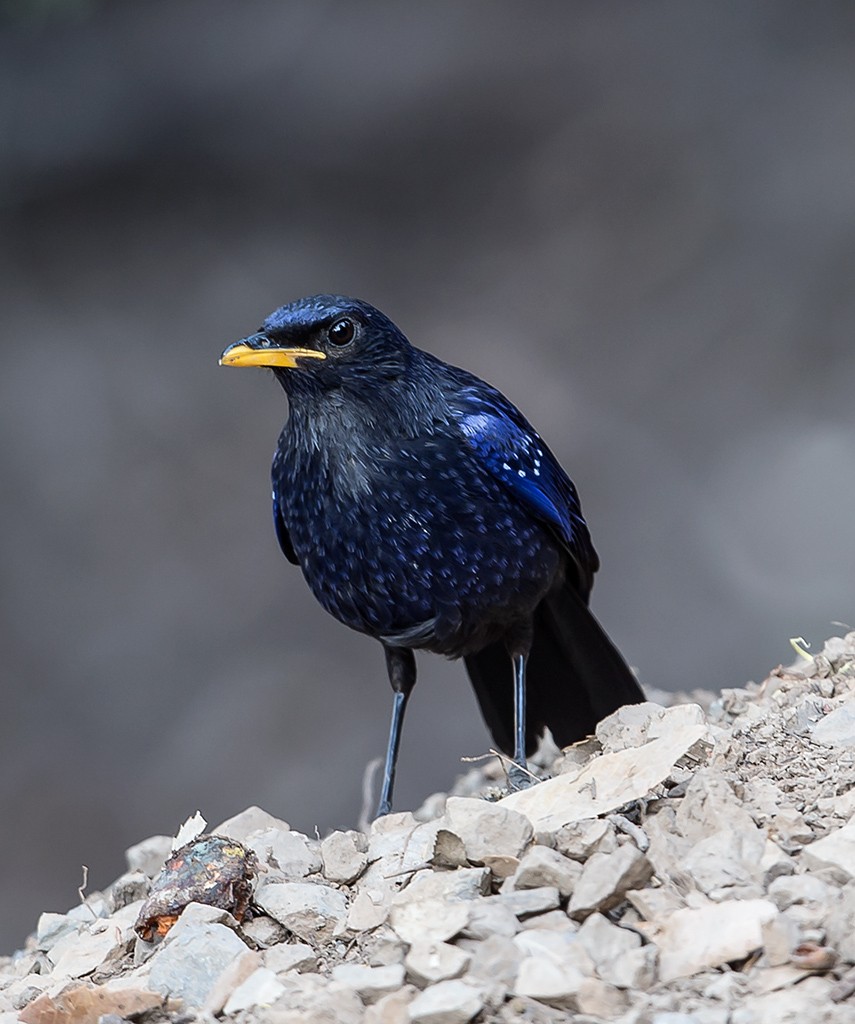Blue Whistling Thrush
A species of Whistling thrushes Scientific name : Myophonus caeruleus Genus : Whistling thrushes
Blue Whistling Thrush, A species of Whistling thrushes
Botanical name: Myophonus caeruleus
Genus: Whistling thrushes
Content
Description People often ask General Info
Description
This whistling thrush is dark violet blue with shiny spangling on the tips of the body feathers other than on the lores, abdomen and under the tail. The wing coverts are a slightly different shade of blue and the median coverts have white spots at their tips. The bill is yellow and stands in contrast. The inner webs of the flight and tail feathers is black. The sexes are similar in plumage. It measures 31–35 cm (12–14 in) in length. Weight across the subspecies can range from 136 to 231 g (4.8 to 8.1 oz). For comparison, the blue whistling thrush commonly weighs twice as much as an American robin. This species is possibly the largest extant thrush though size overlap does occur with the similar by length great thrush and the insular Amami thrush, whose mean body mass falls around the middle of those of the whistling thrush. Among standard measurements, the wing chord can measure 15.5–20 cm (6.1–7.9 in) long, the tarsus is 4.5–5.5 cm (1.8–2.2 in) and the bill is 2.9–4.6 cm (1.1–1.8 in). Size varies across the range with larger thrushes found to the north of the species range and slightly smaller ones to the south, corresponding with Bergmann's rule. In northern China, males and females average 188 g (6.6 oz) and 171 g (6.0 oz), whereas in India they average 167.5 g (5.91 oz) and 158.5 g (5.59 oz). Several populations are given subspecies status. The nominate form with a black bill is found in central and eastern China. The population in Afghanistan, turkestanicus, is often included in the widespread temminckii which has a smaller bill width at the base and is found along the Himalayas east to northern Burma. The population eugenei, which lacks white spots on the median coverts, is found south into Thailand. Cambodia and the Malay peninsula have crassirostris, while dichrorhynchus with smaller spangles occurs further south and in Sumatra. The Javan population, flavirostris, has the thickest bill. The subspecies status of several populations has been questioned. 
Size
35 cm
Colors
Black
White
Blue
Purple
Nest Placement
Cliff
Feeding Habits
Blue Whistling Thrush consumes a varied diet of fruits, earthworms, insects, crabs, and snails. It employs a unique method of battering snails and crabs against rocks to break them open. In captivity, it can prey on mice, and in the wild, it may occasionally hunt small birds.
Habitat
Blue Whistling Thrush resides primarily in temperate and subtropical/tropical moist montane forests, favoring areas with running water like gorges and streams. Habitats range from broadleaf evergreen to mixed deciduous forests and open areas with scattered trees. Seasonally, blue Whistling Thrush occupies altitudes from 1000-4000 m, descending to coastlines and mangroves up to 2400 m in winter.
Dite type
Omnivorous
People often ask
General Info
Feeding Habits
Bird food type
Behavior
The blue whistling thrush is usually found singly or in pairs. They hop on rocks and move about in quick spurts. They turn over leaves and small stones, cocking their head and checking for movements of prey. When alarmed they spread and droop their tail. They are active well after dusk and during the breeding season (April to August) they tend to sing during the darkness of dawn and dusk when few other birds are calling. The call precedes sunrise the most during November. The alarm call is a shrill kree. The nest is a cup of moss and roots placed in a ledge or hollow beside a stream. The usual clutch consists of 3 to 4 eggs, the pair sometimes raising a second brood. They feed on fruits, earthworms, insects, crabs and snails. Snails and crabs are typically battered on a rock before feeding. In captivity, they have been known to kill and eat mice and in the wild have been recorded preying on small birds. 
Distribution Area
It is found along the Tian Shan and Himalayas, in temperate forests and subtropical or tropical moist montane forests. The species ranges across Afghanistan, Bangladesh, Bhutan, Cambodia, India, Indonesia, Kazakhstan, Laos, Malaysia, Myanmar, Nepal, Tajikistan, Thailand, Tibet, Turkmenistan, and Vietnam. They make altitudinal movements in the Himalayas, descending in winter. 
Species Status
Not globally threatened.
Scientific Classification
Phylum
Chordates Class
Birds Order
Perching birds Family
Old world flycatchers Genus
Whistling thrushes Species
Blue Whistling Thrush 